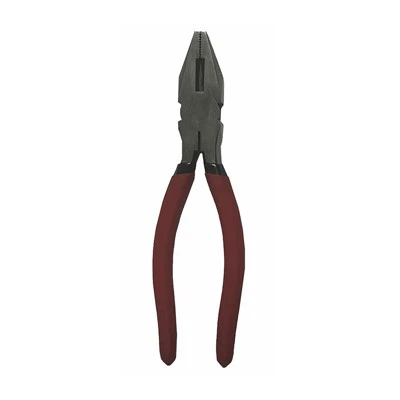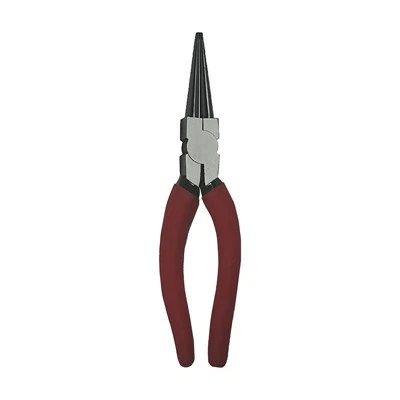Can long reach nose pliers be used in tight spaces?
As a supplier of Long Reach Nose Pliers, I often get asked whether these tools can be effectively used in tight spaces. This is a valid question, considering the unique requirements and challenges presented by confined working environments. In this blog post, I'll explore the capabilities of long reach nose pliers in tight spaces, discuss their advantages and limitations, and provide some practical tips for using them effectively.
Understanding Long Reach Nose Pliers
Long reach nose pliers are a specialized type of hand tool designed with an extended jaw and a long, narrow nose. This design allows for greater access to hard-to-reach areas, making them ideal for tasks such as electronics repair, jewelry making, and precision work. The extended reach of these pliers enables users to grip, bend, and manipulate small objects with ease, even in areas that are difficult to access with standard pliers.
Advantages of Using Long Reach Nose Pliers in Tight Spaces
- Enhanced Accessibility: The most significant advantage of long reach nose pliers is their ability to reach into tight spaces. The extended jaw and narrow nose allow users to access areas that would otherwise be inaccessible with standard pliers. This makes them ideal for tasks such as working inside electronic devices, reaching behind panels, or manipulating small components in confined spaces.
- Precision Handling: Long reach nose pliers are designed for precision work. The narrow nose and fine tips allow users to grip and manipulate small objects with great accuracy. This is particularly important in applications where precision is critical, such as electronics repair or jewelry making.
- Reduced Risk of Damage: When working in tight spaces, there is a greater risk of damaging surrounding components or surfaces. Long reach nose pliers help to minimize this risk by allowing users to access the target area without disturbing the surrounding environment. The narrow nose and fine tips also reduce the likelihood of accidentally knocking or damaging nearby components.
Limitations of Using Long Reach Nose Pliers in Tight Spaces
- Limited Maneuverability: While long reach nose pliers provide enhanced access to tight spaces, they can be more difficult to maneuver compared to standard pliers. The extended jaw and long nose can make it challenging to position the pliers accurately, especially in areas with limited clearance. This can make it more difficult to perform certain tasks, such as gripping or bending objects at odd angles.
- Reduced Strength: Long reach nose pliers are typically designed with a thinner and more flexible jaw compared to standard pliers. This can result in reduced strength and gripping power, making them less suitable for tasks that require a high level of force. For example, they may not be able to cut through thick wires or perform heavy-duty gripping tasks.
- Increased Risk of Breakage: The extended jaw and long nose of long reach nose pliers can make them more prone to breakage or damage. This is especially true if the pliers are used to apply excessive force or if they are subjected to repeated bending or twisting. It is important to use long reach nose pliers within their recommended limits and to handle them with care to avoid breakage.
Tips for Using Long Reach Nose Pliers in Tight Spaces
- Choose the Right Pliers: Not all long reach nose pliers are created equal. When selecting pliers for use in tight spaces, it is important to choose a pair that is specifically designed for the task at hand. Look for pliers with a narrow nose, fine tips, and a comfortable grip. Consider the length of the jaw and the overall size of the pliers to ensure that they will fit into the tight space you need to work in.
- Use the Right Technique: Using the right technique is essential when working with long reach nose pliers in tight spaces. Start by positioning the pliers as close to the target object as possible. Use the fine tips of the pliers to grip the object firmly, and apply gentle pressure to avoid damaging the surrounding components. If necessary, use a small mirror or other tool to help you see the target area more clearly.
- Take Your Time: Working in tight spaces can be challenging, so it is important to take your time and work carefully. Avoid rushing or applying excessive force, as this can increase the risk of damage or injury. If you are having difficulty accessing the target area, try adjusting the position of the pliers or using a different technique.
- Maintain Your Pliers: Proper maintenance is essential to ensure the longevity and performance of your long reach nose pliers. Keep the pliers clean and dry, and lubricate the pivot point regularly to ensure smooth operation. Check the tips of the pliers for wear or damage, and replace them if necessary.
Conclusion
In conclusion, long reach nose pliers can be a valuable tool for working in tight spaces. Their extended jaw and narrow nose provide enhanced access to hard-to-reach areas, making them ideal for tasks such as electronics repair, jewelry making, and precision work. However, they do have some limitations, such as limited maneuverability and reduced strength. By choosing the right pliers, using the right technique, taking your time, and maintaining your pliers, you can effectively use long reach nose pliers in tight spaces and achieve excellent results.
If you're in the market for high-quality long reach nose pliers or other hand tools, we invite you to explore our product range. We offer a wide selection of Mini Pliers Set, Long Reach Bent Nose Plier, and American Type Heavy Duty Diagonal Cutting Pliers that are designed to meet the needs of professionals and DIY enthusiasts alike. Our products are made from high-quality materials and are built to last. If you have any questions or would like to discuss your specific requirements, please don't hesitate to contact us. We look forward to working with you and helping you find the right tools for your next project.


References
- "Hand Tools: A Comprehensive Guide." Author unknown, Publisher unknown, Publication year unknown.
- "Pliers and Their Uses." Author unknown, Publisher unknown, Publication year unknown.





